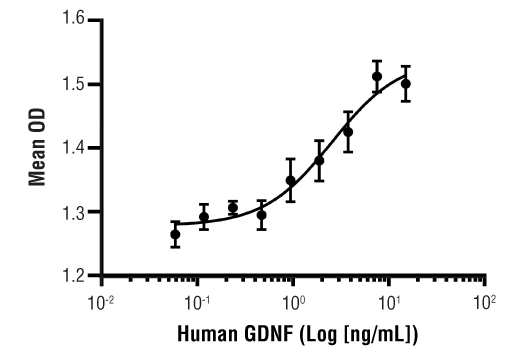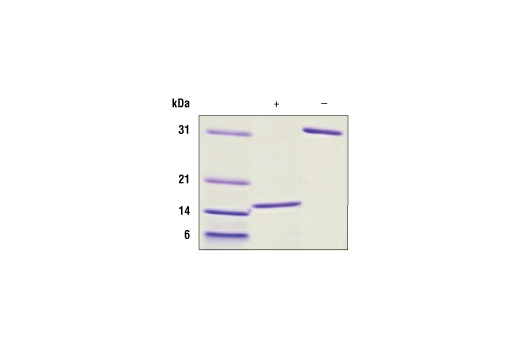30
#P39905
2668
Background
Glial cell-derived neurotrophic factor (GDNF) plays an important role in the development and maintenance of the central and peripheral nervous system, renal morphogenesis, and spermatogenesis (1). This glycosylated, disulfide-bonded homodimer is a member of the TGF-β superfamily and plays an important role in neuronal survival (2). GDNF and the related GDNF family of ligands (GFLs) neurturin, persephin, and artemin bind to the GDNF family receptor α (GFRα) proteins that signal through the Ret receptor tyrosine kinase (3,4). The effect that GDNF has on degenerating dopamine neurons makes it an important growth factor when studying Parkinson’s disease (PD) (5). GDNF has also been identified as a therapeutic target for amyotrophic lateral sclerosis (ALS), is a suggested biomarker for Alzheimer’s Disease (AD), and has been associated with cancer progression (6-9).
- Fielder, G.C. et al. (2018) Neoplasia 20, 99-117.
- Choi-Lundberg, D.L. et al. (1997) Science 275, 838-41.
- Sariola, H. and Saarma, M. (2003) J Cell Sci 116, 3855-62.
- Tallini, G. and Asa, S.L. (2001) Adv Anat Pathol 8, 345-54.
- Konishi, Y. et al. (2014) J Neurosci 34, 13127-38.
- Cintrón-Colón, A.F. et al. (2020) Cell Tissue Res 382, 47-56.
- Sharif, M. et al. (2021) Neurol Sci 42, 2865-2872.
- Choi, Y.D. et al. (2020) Int J Mol Sci 21, 3586. doi: 10.3390/ijms21103586.
- Yu, Z. et al. (2022) Int J Oncol 61, 109. doi: 10.3892/ijo.2022.5399.
Endotoxin
Endotoxin levels are less than or equal to 1 EU / 1 μg hGDNF.
Purity
A greater than or equal to 95% purity was determined by SDS-PAGE.
Source / Purification
Recombinant human GDNF was expressed in E. coli and is supplied in a lyophilized form.
Bioactivity
The bioactivity of recombinant hGDNF was determined in a C6 cell proliferation assay. The ED50 of each lot is less than or equal to 3 μg/ml.
Background
Glial cell-derived neurotrophic factor (GDNF) plays an important role in the development and maintenance of the central and peripheral nervous system, renal morphogenesis, and spermatogenesis (1). This glycosylated, disulfide-bonded homodimer is a member of the TGF-β superfamily and plays an important role in neuronal survival (2). GDNF and the related GDNF family of ligands (GFLs) neurturin, persephin, and artemin bind to the GDNF family receptor α (GFRα) proteins that signal through the Ret receptor tyrosine kinase (3,4). The effect that GDNF has on degenerating dopamine neurons makes it an important growth factor when studying Parkinson’s disease (PD) (5). GDNF has also been identified as a therapeutic target for amyotrophic lateral sclerosis (ALS), is a suggested biomarker for Alzheimer’s Disease (AD), and has been associated with cancer progression (6-9).
Background References
Cross-Reactivity Key
H: human M: mouse R: rat Hm: hamster Mk: monkey Vir: virus Mi: mink C: chicken Dm: D. melanogaster X: Xenopus Z: zebrafish B: bovine Dg: dog Pg: pig Sc: S. cerevisiae Ce: C. elegans Hr: horse GP: Guinea Pig Rab: rabbit All: all species expected
Trademarks and Patents
Limited Uses
Except as otherwise expressly agreed in a writing signed by a legally authorized representative of CST, the following terms apply to Products provided by CST, its affiliates or its distributors. Any Customer's terms and conditions that are in addition to, or different from, those contained herein, unless separately accepted in writing by a legally authorized representative of CST, are rejected and are of no force or effect.
Products are labeled with For Research Use Only or a similar labeling statement and have not been approved, cleared, or licensed by the FDA or other regulatory foreign or domestic entity, for any purpose. Customer shall not use any Product for any diagnostic or therapeutic purpose, or otherwise in any manner that conflicts with its labeling statement. Products sold or licensed by CST are provided for Customer as the end-user and solely for research and development uses. Any use of Product for diagnostic, prophylactic or therapeutic purposes, or any purchase of Product for resale (alone or as a component) or other commercial purpose, requires a separate license from CST. Customer shall (a) not sell, license, loan, donate or otherwise transfer or make available any Product to any third party, whether alone or in combination with other materials, or use the Products to manufacture any commercial products, (b) not copy, modify, reverse engineer, decompile, disassemble or otherwise attempt to discover the underlying structure or technology of the Products, or use the Products for the purpose of developing any products or services that would compete with CST products or services, (c) not alter or remove from the Products any trademarks, trade names, logos, patent or copyright notices or markings, (d) use the Products solely in accordance with CST Product Terms of Sale and any applicable documentation, and (e) comply with any license, terms of service or similar agreement with respect to any third party products or services used by Customer in connection with the Products.

